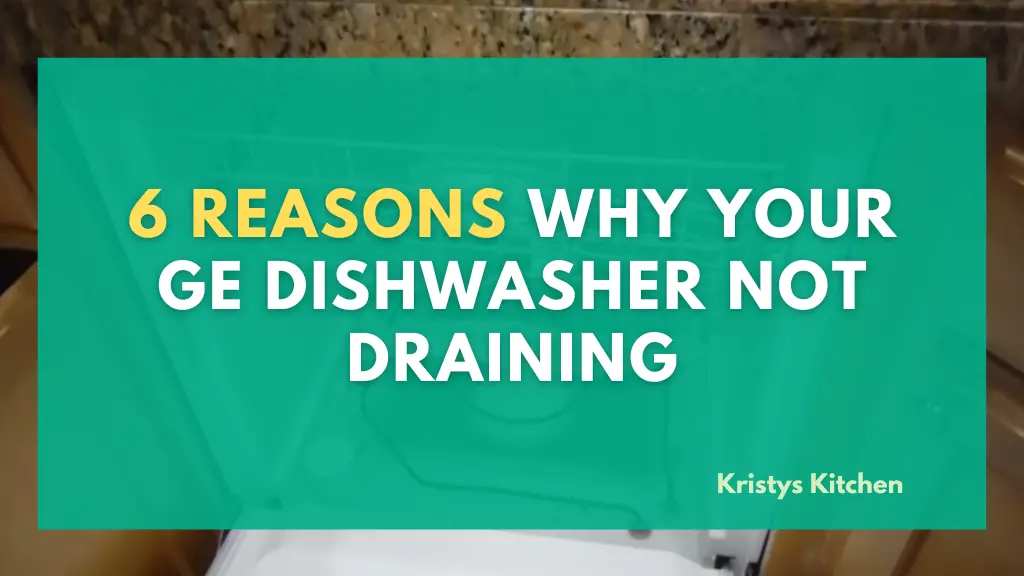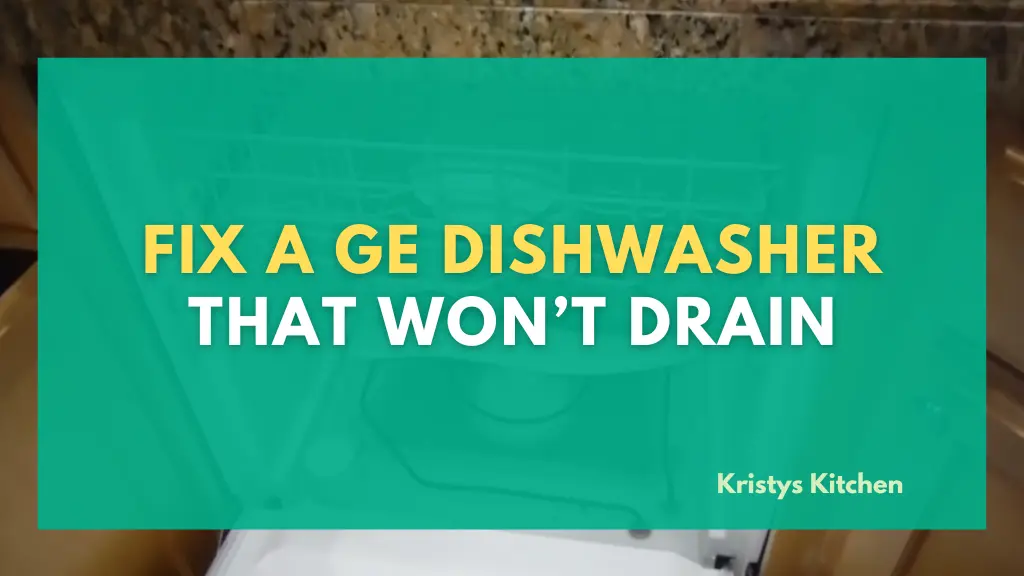GE Dishwasher Not Draining: 6 Fixes To Stop Water Mishaps
If your GE dishwasher is not draining and keeps having pools of water in it, that could be due to air gap problems, clogged filters, hose blockages, or disposer and dishwasher installation issues. To fix, clean the filters, check and clear the hose, maintain the air gap, unplug the disposal plug, use detergent correctly, and ensure proper installation.
I’ll give you a quick rundown on how to deal with all that correctly. The process is a bit more specific with GE washers. Keep reading to learn more.
Why Is Your New GE Dishwasher Not Draining?
The below reasons can lead to your GE dishwasher not draining:

Reason 1: Clogged Air Gap
The air gap on your sink is incredibly important for dishwasher drainage.
Debris buildup in the air gap can disrupt water flow.
The air gap is supposed to ensure smooth drainage, but if it’s filled with gunk, water can’t flow properly.
Reason 2: Filter and Sump Obstructions
Over time, the filters in GE dishwashers gather gunk, making them less effective. If they get all clogged up, water can’t flow out properly.
Also, if there’s stuff like paper or large objects covering the sump area, water faces a roadblock on its way out.
Reason 3: Drain Hose and Sink Blockages
The hose that lets water out of the dishwasher can get twisted or blocked.
If there are bends or obstructions in the hose, the water can’t exit easily.
Reason 4: Bad Disposer Installation
When you’re putting in a disposer, if you forget to take out the plug, it blocks the water from draining properly.
This plug acts like a barrier, stopping water from flowing smoothly through the disposer.
Forgetting to remove it messes up how the disposer is supposed to work, causing possible clogs and slowing down the whole draining process.
Reason 5: Incorrect Detergent Usage:
Using the wrong type of detergent or exceeding the recommended amount leads to over-sudsing.
Excessive suds make it difficult for water to drain effectively from the dishwasher, creating drainage problems.
Reason 6: Dishwasher Installation Issues
Proper dishwasher installation is a must for effective drainage. Without an air gap or high loop, water may struggle to drain properly.
Ensuring they’re correctly positioned, connecting the dishwasher to both the counter and sink, promotes efficient water drainage during the dishwasher’s cycle.
How To Fix A GE Dishwasher That Won’t Drain?
Now let me walk you through the best DIY ways to take care of this issue.

Fix 1: Cleaning The Air Gap
- Locate the Air Gap – a chrome cylinder situated near the sink faucet.
- Lift off the chrome cover to expose the air gap.
- Unscrew the plastic cap attached to the air gap.
- Remove any accumulated debris from the air gap and give the plastic cap a thorough rinse.
Verify that the hose connecting the air gap to the sink drain or garbage disposal is clear of any obstructions.
Fix 2: Cleaning The Filters
- Turn off the washer.
- Remove the bottom rack to access filters.
- Take out the Ultra Fine Filter by twisting it counterclockwise.
- Rinse the Ultra Fine Filter with warm soapy water, avoiding scouring pads.
- Reinstall the Ultra Fine Filter by twisting it clockwise using the arrow guide.
- To clean the Fine Filter, remove it by twisting the retaining posts counterclockwise.
- Rinse the Fine Filter with warm soapy water, avoiding scouring pads.
- Reinstall the Fine Filter and the Ultra Fine Filter by twisting the retaining posts clockwise.
| Note: In dishwashers without an Ultra Fine filter, finding 1 to 2 cups of water in the base is normal. For models with the filter, water in the sump is typical, but it shouldn’t cover the tub’s bottom. |
Fix 3: Cleaning The Hose
- Unplug the dishwasher for safety.
- Locate the drain hose at the back, leading to the sink or disposal.
- Check for kinks or misalignment; ensure a secure connection.
- If there’s a clog, detach the hose and clear the debris with a tool.
- Correct any misalignment; secure the hose tightly.
- Plug in the dishwasher, turn on the power, and run a short cycle to test drainage.
- Monitor for leaks and proper water drainage during a full cycle.
| Note: GE recommends against using chemical drain cleaners (e.g., Drain-O, Liquid Plumber) in your dishwasher. They can harm the dishwasher’s rubber parts. Choose alternative solutions for safe maintenance. |
Fix 4: Unplugging Disposal Knockout Plug
- Unplug your disposal and disconnect the dishwasher drain hose if it’s hooked up.
- Locate the drain hole on the disposal. You can use a tool (like a nut driver) from the outside.
- Hit the drain hole a few times with a hammer to break the plug.
- Once broken, use pliers to pull out the plug pieces from inside.
- Hook the dishwasher drain hose back up.
- Power up the disposal by plugging it back in.
- Ensure everything is connected properly, and test if the disposal works.
Fix 5: Using Detergents Correctly
These are some specific instructions I’ve come across in GE manuals. They seemed to work fine for me, so you shouldn’t have any problems.
- Choose quality detergents like Cascade Platinum or Finish Quantum for optimal cleaning.
- Follow detergent packaging and your dishwasher’s manual for precise dosage based on water hardness and soiling level.
- Store detergent in a sealed container, guarding against moisture. Note that powder detergent may lose potency over time.
- Open the dry detergent dispenser on your dishwasher door.
- Add the exact detergent amount recommended by the manufacturer and your dishwasher’s manual, considering your dishwasher’s size.
- Enhance results with rinse agents like Cascade Platinum Power Dry or Finish Jet-Dry. Refer to your manual for the optimal quantity.
Fix 6: Double Check If Dishwasher Is Installed Correctly
- Verify the air gap or high loop proximity to the counter underside.
- Ensure the drain pipe is positioned before, not after, the P-trap.
- Secure the high loop with a zip tie, maintaining a height of 32 inches above the ground.
- Double-check the correct placement of the water-tight gasket.
- Confirm the outlet spout is directed toward the sink for overflow management.
- If using a high loop, ensure it’s installed before the P-trap and close to the counter.
If you notice any discrepancies, feel free to call in the technician who installed it and tell them to take a look at the dishwasher again.
| The above reasons apply when the dishwasher is showing the FTD code and fails to drain properly. |
FAQs
Why is my GE dishwasher humming but not draining?
Your GE dishwasher is humming because something is jamming the drain pump, hindering the impeller blades from spinning and stopping water flow.
Is there a drain only cycle in GE dishwashers?
Yes, there is – though there’s no direct button you can press. To drain your GE dishwasher, press and hold the start button for 3 seconds. Listen for the draining sound and wait until it stops. Repeat if needed.
Final Thoughts
With these steps, your GE dishwasher should be able to unload water properly now.
Enjoy the convenience of a smoothly functioning appliance and wave goodbye to drainage concerns.
Good luck with dishwashing in peace!
